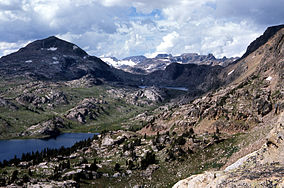Absaroka–Beartooth Wilderness
Protected wilderness area in Montana and Wyoming, United States From Wikipedia, the free encyclopedia
Protected wilderness area in Montana and Wyoming, United States From Wikipedia, the free encyclopedia
Absaroka–Beartooth Wilderness was created from existing National Forest lands in 1978 [1][2] and is located in Montana and Wyoming, United States. The wilderness encompasses two distinct mountain ranges: the Beartooth and Absaroka ranges. These ranges are completely distinct geologically speaking, with the Absaroka composed primarily of volcanic (or extrusive) and metamorphic rock, while the Beartooth is made up almost entirely of granitic rocks. The Absaroka are noted for their dark and craggy appearance, lush and heavily forested valleys, and abundant wildlife. The highest peak in the range, in Wyoming, is Francs Peak at 13,153 feet (4,009 m). The Beartooth is more alpine, with huge treeless plateaus and the highest peak of Montana (Granite Peak 12,799 feet (3,901 m)). The wilderness has more than 120 peaks over 10,000 feet (3,000 m) and 28 peaks over 12,000 feet (3,700 m), including Montana's highest, Granite Peak at 12,799 feet (3,901 m).[3] The wilderness is integral to the 20-million-acre (81,000 km2) Greater Yellowstone Ecosystem and borders Yellowstone National Park.
| Absaroka–Beartooth Wilderness | |
|---|---|
 | |
| Location | Montana / Wyoming, USA |
| Nearest city | Red Lodge, MT |
| Coordinates | 45°6′N 109°56′W |
| Area | 944,000 acres (3,820 km2) |
| Established | 1978 |
| Governing body | U.S. Forest Service |
Wilderness areas do not allow motorized or mechanical equipment, including bicycles, hang-gliders, wagons, chainsaws, and game carts.[4] Although camping and fishing are allowed with proper permits, no roads or buildings are constructed, and no logging or mining allowed, in compliance with the 1964 Wilderness Act. Wilderness areas within National Forests and Bureau of Land Management areas also allow hunting in season.
There are 700 miles (1,100 km) of trails in the wilderness, hundreds of lakes, a few dozen streams, and a similar number of small glaciers can be found in the wilderness. The forests are dominated by various species of spruce, fir, and pine, while in the Beartooth Mountains, due to the altitude, tundra conditions often prevail. The Beartooth has the largest unbroken area of land over 10,000 feet (3,000 m) in altitude in the U.S. outside of Alaska. Animals found in the wilderness include bald eagles, Yellowstone cutthroat trout, threatened grizzly bears, lynx, and the gray wolf.
Access to the wilderness is difficult but can be achieved via the Beartooth Highway US 212 from Red Lodge, Montana. There are also some forest access roads from the west off of US 89 south of Livingston, Montana.[citation needed]
The wilderness spans the Montana-Wyoming border on Gallatin, Custer and Shoshone National Forests and is composed of 944,000 acres (3,820 km2).[5] The elevation ranges from 0 to 11,000 feet (3,400 m); the maximum elevation is at the Beartooth Plateau, located high in the Beartooth Mountains.[6]
In a study of reaction of learning how large carnivores would react to the big-game hunting season in Yellowstone National Park, a group of scientists found out that grizzly bear (Ursus arctos) usually stay inside the Yellowstone National Park and start moving north (into the Absaroka - Beartooth Wilderness) when the hunting starts. At the same region, cougars (Puma concolor) from outside of the Yellowstone National Park tends to go inside when the hunting starts. However, wolves (Canis lupus) don't change their position as they are already spreading in the Yellowstone Nation Park area. During the hunting season, all of them are found to be hunting elk (Cervus elaphus) on the north of the Park, where Absaroka–Beartooth Wilderness is.[7]
According to the wilderness regulation, group size is limited for 15 people and 15 combined pack and saddle stock.[4]
The widespread detection of total coliforms, Bacteroides, and E coli in the water sources of the wilderness area is leading to the question of whether it's because of the increasing human visitation. Visitors of the wilderness are encouraged to purify the water carefully before consumption.[8] The wilderness has imposed some regulations to protect the water source, such as camping and burying human waste within 200 feet (61 m) of lake or stream is prohibited, and waste has to be buried 6 inches (15 cm)-8 inches (20 cm) deep.[4]
Seamless Wikipedia browsing. On steroids.